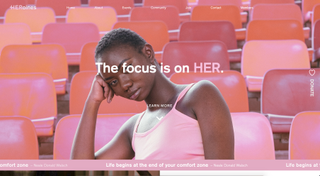How Wix is helping designers and clients create better sites
The head of design and branding at Wix, Hagit Kaufman, shares how its Design Playground is changing the game.

Earlier this month, cloud-based web development platform Wix presented the culmination of its three-month-long 2019 Design Playground. This programme saw selected designers work closely with a batch of non-profits to improve their websites thanks to the help and resources provided by Wix.
It was an incredible presentation, with the heads of non-profits collectively blown away by how the group of young designers reimagined their online presence. Gone were the clumsy layouts and reams of text that bogged down previous websites. In their place were slick pages that elegantly explained mission statements, all displayed in creative and eye-catching ways. One non-profit owner even revealed that the whole process helped him to understand his company better.
For the designers that took part, it was also an invaluable opportunity to hear from big design names, experiment with web design tools and learn new skills that will help to further their budding careers.
We’ll be hearing how the Design Playground benefited the designers in a later post. But in the meantime, we caught up with the head of design and branding at Wix, Hagit Kaufman, to hear how the program came about, how it's helping to improve Wix, and and what it means for the relationship between designers and clients.
Bridging the design disconnect

The Design Playground, which has been running since 2018, is an idea that Kaufman has been carrying for some years. And it can trace its roots back to a recurring issue. “I’d realised that designers who work for a tech company spend all their time working with the technology people, and they're focused so much on the product that they're losing the connection to the real people,” she explains.
On top of that, Kaufman noticed that these designers had become increasingly disconnected from the process of building a website. This included how to arrange content, talk to the client, and deal with clients who might not necessarily know what they want.
“So we said, ‘Okay, I need to bring clients in, and I need my designers to design a website for a real person’,” she reveals. This lead to the creation of a hackathon for designers, where they had three days to connect with non-profits who were invited into the Wix studio.
Get the Creative Bloq Newsletter
Daily design news, reviews, how-tos and more, as picked by the editors.
“But then, after three days, they had to build the website,” Kaufman says. “So it was like, around the clock. We wrote the content, we took photos, and we did everything in three days.”
This precursor to the Playground Academy made Kaufman realise that designers have to learn how to manage their clients. And for Wix, it was a chance to better understand their product and learn how to improve it. “So I think everyone wins,” adds Kaufman. “We give back to the community, and learn from it as well.”
Learning curve

So what has Kaufman learnt from the Design Playground? “Wow, so many things,” she says. “As a designer I really want to have the best website. I want it to be very elegant, and well-designed and trendy. And those kinds of things are not always in the needs of the client.”
She’s not alone with this approach. Throughout the course of the Design Playground, creators had to be reined in. “We saw that we had to keep the designers very close to the ground, and not let them go crazy with special effects and designs.”
Creating trendy sites and keeping ideas in check might seem like contradictory ambitions, but there’s a good reason for this. Kaufman explains that the client should be able to keep updating their website as they go, rather than having a designer on a retainer who’s ready to leap in at a moment’s notice to tweak various elements.
This meant that sites needed to be simple. “And before, sometimes, we had to compromise on the design,” she says. “And this is something that I’m taking back to the product: how can I arrange all the content on the site without the client needing to go into the editor and play with things that they don't always know how to put in place?”
Web design trends

Speaking of trendy design elements, a lot of the sites on display at the Wix Design Playground showcased traditional art techniques, tactile elements, and animation. But is there more to a flashy effect than cashing in on a current trend?
“Design trends are going in circles,” says Kaufman, “But the designing for an organisation is all about the clients and their audience.”
To this extent, Kaufman thinks that the design students did a great job of figuring out their non-profit’s audience, building platforms for people that want to use their sites, and understanding how to get them clicking on the donate button.
The circular nature of web design trends isn’t bad news though. “A fun thing about web design is that it’s so easy to change,” Kaufman adds. “And it gets faster and faster. We had flat design, and then we had shadows, and then sections, and then we went back to flat design. So we’re going in circles. And every time we add to it something from the technology that has come in, and it helps to update the design and make it great again.
Building a successful brand

Making a website great, whether it’s a non-profit or otherwise, is all part of developing a successful brand. And considering that Kaufman has helped to grow Wix from a company that only had five designers when she started, clearly she knows how to build a brand.
So what’s her advice for designers looking to create a successful brand and website? “I think they need to keep in mind that websites are only part of an identity,” she says. “They’re not all of it.”
“They’re supposed to arrange everything together, to combine the message. It's not about the website, it's about the business. You need to know how to combine everything together to create a great website that pushes the message forwards.”
“It's a huge part of the brand though, because everyone sees your business through your website or your blog. The designer always needs to remember that the website is supposed to be a part of something bigger.”
If you'd like to get involved with the 2020 Design Playground and take your design skills further, apply here.
Related articles:

Thank you for reading 5 articles this month* Join now for unlimited access
Enjoy your first month for just £1 / $1 / €1
*Read 5 free articles per month without a subscription

Join now for unlimited access
Try first month for just £1 / $1 / €1

Dom Carter is a freelance writer who specialises in art and design. Formerly a staff writer for Creative Bloq, his work has also appeared on Creative Boom and in the pages of ImagineFX, Computer Arts, 3D World, and .net. He has been a D&AD New Blood judge, and has a particular interest in picture books.